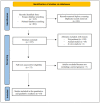Relationship between Iron Deficiency and Thyroid Function: A Systematic Review and Meta-Analysis
- PMID: 38004184
- PMCID: PMC10675576
- DOI: 10.3390/nu15224790
Relationship between Iron Deficiency and Thyroid Function: A Systematic Review and Meta-Analysis
Abstract
Objective: Iron deficiency (ID) is the most prevalent nutritional deficiency worldwide. Low levels of serum ferritin (SF) could affect the thyroid gland and its functioning. The purpose of this systematic review and meta-analysis is to summarize the main currently available evidence and analyze data on the relationship between ID and thyroid function. Methods: This study included all articles evaluating the relationship between ID and thyroid function. Quality assessment was performed using Cambridge Quality Checklists. The search strategy included the following combination of Medical Subjects Headings terms and keywords: "iron deficiency", "thyroid function", "thyroid disease", "thyroid dysfunction", and "hypothyroidism". A meta-analysis was performed to evaluate whether thyroid stimulating hormone (TSH), free thyroxine (FT4), and free triiodothyronine (FT3) levels differed between patients with ID and healthy controls without ID. For statistical comparison between cases and controls, the mean difference (MD) was calculated, and a subgroup analysis of pregnant and non-pregnant women was performed. Cochran's Q testing and heterogeneity indices (I2) were used to assess statistical heterogeneity. Sensitivity analysis and publication bias analyses were also performed, both qualitatively and quantitatively. Finally, a meta-regression analysis was performed to evaluate the correlation between serum TSH or FT4 levels and SF in the study population. Results: Ten cross-sectional studies were identified and reviewed. Patients with ID showed TSH (MD: -0.24 mIU/L; 95% CI -0.41, -0.07; I2 = 100%, p = 0.005), FT4 (MD: -1.18 pmol/L; 95% CI -1.43, -0.94; I2 = 99%, p < 0.000001), and FT3 (MD: -0.22 pmol/L; 95% CI -0.32, -0.12; I2 = 99%, p < 0.00001) levels that were significantly lower. Subgroup analysis confirmed significantly lower TSH, FT4, and FT3 levels in pregnant women. Non-pregnant women showed significantly lower serum FT4 and FT3 levels but no difference in TSH values. Meta-regression analysis showed that serum TSH and FT4 levels were positively correlated with SF levels. Our systematic review of the literature found that ID significantly increases the prevalence of thyroid autoantibody (anti-thyroglobulin antibodies and anti-thyroid peroxidase antibodies) positivity both individually and collectively. Conclusion: Studies currently published in the literature indicate a possible relationship between ID, thyroid function, and autoimmunity, especially in some patient groups. Data analysis shows that thyroid hormone levels are lower in patients with ID and, in particular, in pregnant women. Further studies are needed to understand the role played by iron in thyroid metabolism.
Keywords: hypothyroidism; iron deficiency; thyroid disease; thyroid dysfunction; thyroid function.
Conflict of interest statement
The authors declare no conflict of interest.
Figures









References
Publication types
MeSH terms
Substances
LinkOut - more resources
Full Text Sources
Medical

